Want to see the northern lights? In this introduction to auroral phenomena, an expert explains what to look for, when, and how.
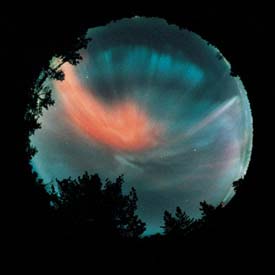
The earliest known references to auroras date back to the Old Testament, and in the 2,500 years since then the northern lights have fascinated casual skywatchers and scientists alike. But probably fewer than 5% of Earth's inhabitants during this period have ever seen an aurora, since auroras usually appear only at high northern and southern latitudes, far from the world's population centers.
However, dedicated skywatchers who keep their eyes open have a much better chance of seeing them.

Sky & Telescope: Gregg Dinderman
When and Where to Look for Auroras
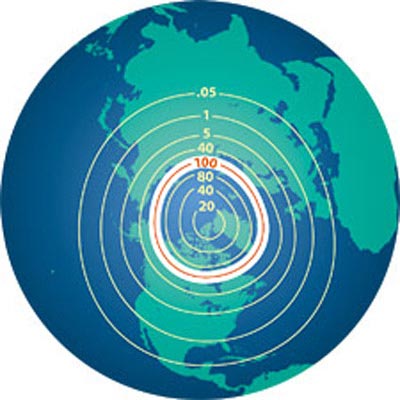
Courtesy Robert Eather.
The aurora is a more or less permanent feature of Earth's high latitudes. It is usually confined to two large, thin ovals encircling the Earth's north and south magnetic poles. Nighttime satellite pictures routinely show these so-called auroral ovals as halos of light crowning the top and bottom of the globe (an example appears at lower right).
One can talk about the auroral oval in two ways. The "statistical oval" is its average location at a given level of magnetic activity; the "instantaneous oval" is the aurora's actual location at a particular moment. The statistical oval can be used to estimate the likelihood of seeing auroras from a particular site. On any given night, the instantaneous oval often falls elsewhere.
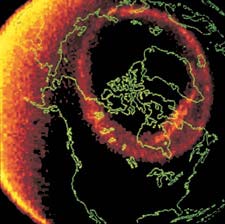
Courtesy Louis A. Frank, University of Iowa.
To complicate matters further, auroral activity is spasmodic and often culminates in a period of spectacular activity called a substorm. Substorms usually occur around local midnight. They cause the instantaneous oval to rapidly expand poleward.
The auroral ovals are two halos of light (the aurora borealis and the aurora australis) about 110 kilometers above the Earth and centered on the magnetic poles. The Earth rotates under these halos about its geographic axis. This means that at far northern latitudes, near the oval's ordinary "home" location, some simple rules of thumb apply. In central Alaska or northern Scandinavia, on most nights you can expect to rotate directly under the oval in the midevening hours, be inside it (poleward of it) around midnight, and pass under it again before dawn. Thus one expects to see the aurora move from the northern sky shortly after dark, to overhead at midevening, and to the south around midnight, then back overhead again in the early hours of the morning.
At the lower latitudes where most of us live, however, we are usually so far equatorward of the auroral oval that we can't see it at all. When we can, we almost always have to look near the north horizon (for observers in the Northern Hemisphere). Because the oval extends farthest toward the equator around the middle of the night, that is the best time for would-be aurora watchers at temperate latitudes to look.
During magnetic storms the auroral oval expands to lower latitudes and we can see a display earlier in the evening and higher in the sky or even overhead. During a rare large storm, the oval may expand so far toward the equator that it can be seen from the tropics, while skywatchers at midnorthern latitudes actually find themselves facing south.
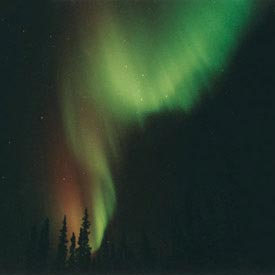
Courtesy Donald E. Cartier Sr.
Fortunately for today's aurora watchers, magnetic storms can often be forecast a day or two in advance. The tip-off is a solar flare near the center of the Sun's disk or a coronal mass ejection aimed toward Earth. A worldwide array of observatories constantly monitors the Sun for such events. The Sun always gives off a solar wind, composed mostly of electrons and protons, which interacts with the Earth's magnetic field to light the auroral oval. A solar eruption can make the solar wind come thicker and faster, with gusts that buffet the Earth's magnetosphere and power up the auroral oval accordingly. These wind enhancements take one or two days to reach us, allowing time to plan.
Shapes and Forms of Northern Lights
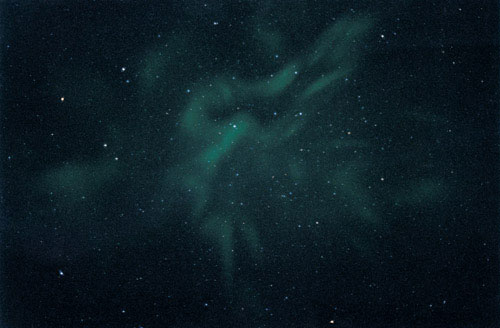
Courtesy Jim Starr.
The variety of shapes, colors, and movements of auroras are infinite. Like snowflakes, no two are alike. Faced with such a bewildering variety, early scientists tried to take control of the situation by classifying auroras into types and subtypes. These often unwieldy classifications may be found in the International Auroral Atlas (1963). For example, "a3p2mR2B3e" would describe a bright red and green multiple-rayed band, with medium-length rays showing horizontal movement and flaming activity!
In 25 years of auroral research, I do not recall ever having seen such classifications used in any productive scientific way. Indeed, the days of useful amateur visual auroral observations are probably past. Auroral research is much more sophisticated now and relies on low-light-level imaging or interferometric systems (often deployed in arrays covering a range of latitudes), together with simultaneous observations carried out by ground-based magnetometers and radars as well as instruments on satellites.
Nevertheless, a simplified vocabulary of auroral types is good to have. Here are what I consider useful descriptive terms for auroral forms, structures, motions, and brightnesses.
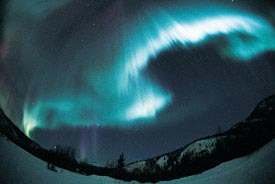
Forms
Auroras come in five basic shapes.
- Arcs are simple, slightly curved bands of light with smooth bottom edges.
- Bands have continuous but irregular lower edges characterized by kinks or folds.
- Patches are small, isolated regions of glow.
- Veils are extensive, uniform glows covering an appreciable fraction of the sky.
- Rays are shafts of light. They follow the Earth's magnetic field lines and tend to extend vertically.
Structures
The five forms above show one of three types of internal structure.
- Homogeneous, or smooth.
- Striated, made of irregular fine lines or filaments.
- Rayed, made of definite rays larger than filaments.
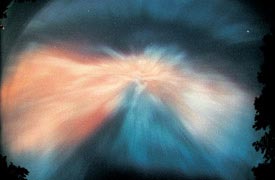
Courtesy Pekka Parviainen.
Two especially striking combinations occur frequently and deserve special mention. A curtain (or drapery) is a rayed band looped in dramatic folds. A corona is a group of rays that appears to converge on a point high in the sky. This is a perspective effect caused when we look directly up along a bundle of parallel magnetic field lines.
Amateurs have dubbed another recently observed auroral pattern — a mauve arc, sometimes accompanied by green "picket fence" stripes — "Steve." However, whether this is truly an aurora is up for debate.
Temporal Behavior and Brightness
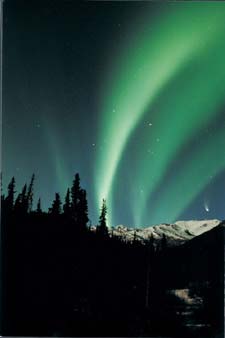
Courtesy Michael Klensch
Temporal Behavior
An aurora may be motionless, or it may change or move.
- Quiet means steady for a fairly long time, with only gradual, nonrepeating changes.
- Pulsating denotes brightness increasing and decreasing more or less periodically.
- Flickering refers to fast pulsating (say 5 or 10 times per second, up to a speed the human eye can no longer resolve).
- Flaming describes bursts of luminosity appearing at the base of a form and rushing upward.
Brightness
Auroras have a wide range of brightness, usually rated from 0 to 4 on a logarithmic scale (the International Brightness Coefficient, or IBC) in which each number is 10 times brighter than the previous one.
- Zero means subvisual, detected only with instruments.
- One is comparable to the Milky Way; whitish with no discernible color.
- Two is comparable to moonlit cirrus clouds; color is barely identifiable (usually yellow-green).
- Three is like brightly lit cirrus or moonlit cumulus clouds; colors are evident.
- Four is much brighter than three; may cast discernible shadows; good colors, many of them fleeting.
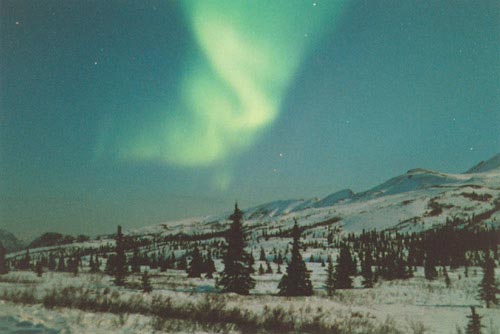
Courtesy Michael Klensch.
If you can see any color, the aurora is at least IBC 2. When it's hard to see bright stars through an aurora, it's IBC 3 or brighter.
These terms will help you recognize, describe, and understand what you see. Every solar cycle offers numerous opportunities to see fine displays of the northern (and southern) lights for some time to come. Although still an inexact science, aurora predictions are available on a number of websites. So make the most of the opportunity, and good luck!
 0
0
Comments
You must be logged in to post a comment.